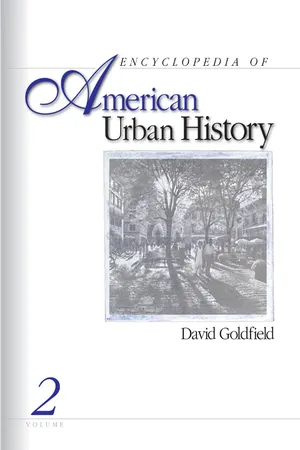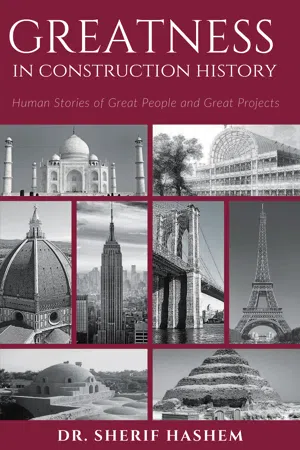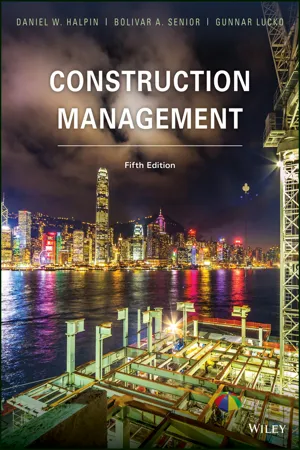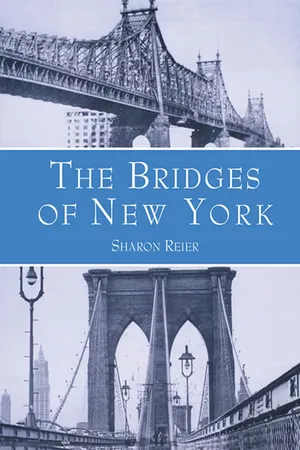Technology & Engineering
Brooklyn Bridge
The Brooklyn Bridge is a historic suspension bridge that spans the East River, connecting Manhattan and Brooklyn in New York City. Designed by John A. Roebling and completed in 1883, it was one of the first bridges to use steel-wire cables, revolutionizing bridge engineering. The bridge's iconic design and innovative construction techniques have made it a symbol of American ingenuity and progress.
Written by Perlego with AI-assistance
Related key terms
1 of 5
4 Key excerpts on "Brooklyn Bridge"
- eBook - PDF
- David Goldfield, David R. Goldfield(Authors)
- 2006(Publication Date)
- SAGE Publications, Inc(Publisher)
Roebling is also known for the innovative method of spinning high tensile steel cables as well as radiating stays, which created aerodynamic sta-bility for the bridge suspended high above the river. The tensile strength of the spidery steel cables pulls them into stretched curves, raylike lines in the sky, and plumb lines reflective of harps. Significant bracing was required from the deck to resist wind and vibration. When it was dedicated in 1883, the Brooklyn Bridge was described as both America’s Arch of Triumph and New York’s Brandenburg Gate. It repre-sented an important and metaphoric point of welcome and announcement of this American city of industry, finance, and immigration. —Martha Bradley See also New York, New York Further Readings and References McCullough, D. (1972). The great bridge. New York: Simon & Schuster. Trachtenberg, A. (1979). Brooklyn Bridge: Fact and symbol. Chicago: University of Chicago Press. B UILDING I NDUSTRY The building industry is responsible for the construc-tion of dwellings. Including builders, subcontractors, tradesmen, and retail building suppliers, it is a major employer in every city. It makes economic growth possible by housing workers and their families, and frames much of the urban landscape. Organized on a local basis, its members are closely connected with other real estate interests, including agents, lawyers, architects, engineers, land developers, and mortgage lenders. These companies are local boosters and influ-ence municipal politics. The activities of the building industry should inter-est economic, business, urban, social, and labor histo-rians. In fact, scholars have neglected it. Information about builders is scattered and has commonly been ignored. From the 1920s to the 1970s, many criticized the industry as “backward” because it failed to con-form to the ideal of mass production exemplified by auto assembly. Fortune magazine declared that house building was the industry capitalism forgot. - eBook - ePub
Greatness in Construction History
Human Stories of Great People and Great Projects
- Sherif Hashem(Author)
- 2022(Publication Date)
- Business Expert Press(Publisher)
Figure 7.11 shows an overview of the bridge in 1933 AD. In 1948 AD, a first major renovation of the Brooklyn Bridge was carried out in 1954 AD. Several renovation and maintenance efforts were and are still being performed by New York City to keep the iconic ancient bridge intact. In 2016 AD, the New York City Department of Transport (NYCDOT) announced a plan to reinforce the Brooklyn Bridge’s foundations and repair the masonry arches on the approach ramps. In 2018 AD, the New York City Landmarks Preservation Commission approved a further renovation of the Brooklyn Bridge’s suspension towers and approach ramps. So, in fact, the Brooklyn Bridge has been living on innovations and retrofitting works for quite some time. The ancient stone and steel bridge is getting older by the day, fighting the inevitable natural aging, and resisting the harsh weather of NYC and the marine conditions of the East River. Without a doubt, the East River never liked the Brooklyn Bridge; however, the innocent bridge only wanted to serve the people of Manhattan and Brooklyn. Apologies to the East River, and glory to the Brooklyn Bridge’s caretakers who strive every day to keep the ancient civil engineering icon happy, alive and in good health, serving people and inspiring architects, engineers, artists, and even lovers all over the world.Figure 7.11 Overview of Brooklyn Bridge from Brooklyn showing Manhattan 1933 AD [15 ]7.5 Resolution: The Brooklyn Bridge TodayToday, the Brooklyn Bridge is a key iconic structure on the world stage. It forms a unique and highly recognizable feature on the world’s and the history’s construction skyline. It keeps engineers and architects pondering how it was planned, designed, and built. Brooklyn Bridge simply symbolizes the American dream in terms of opportunity, freedom, and industrialization. It opened the door for all suspension bridges that we see today all over the world. It won numerous professional awards and appeared in endless number of magazines, movies, and songs. In 1964 AD, Brooklyn Bridge was listed as a U.S. National Historic Landmark. In 1966 AD, the bridge was added to the National Register of Historic Places. In 1972 AD, the bridge was named a National Historic Civil Engineering Landmark. And recently, in 2017 AD, it was placed on UNESCO’s list of World Heritage Sites. It earned its status. Figure 7.12 shows a recent photo of the bridge promenade, tower, and cables. The Brooklyn Bridge also became an inspiring world touristic attraction point. I am proud to be a big fan and lover of the Brooklyn Bridge. I remember my first visit to NYC back in 2008 AD. I was in the United States for a PMI project management conference in Denver, Colorado. Finished the conference and decided to “Fly to New York City.” Spent the night in New Jersey at a Holiday Inn, dreaming of the morning in NYC at the Brooklyn Bridge. In the morning, my old friend and classmate picked me up at the hotel with his old tiny Volkswagen, which happened to be a convertible. On the way to Brooklyn Bridge, I was counting the seconds to lay my eyes on the Brooklyn Bridge. When my brain first recorded the bridge image, I found myself yelling, OMG! It’s Brooklyn Bridge! John Augustus Roebling! My friend was astonished by my reaction. In reality, the ancient steel and stone bridge looked so charming. Just like a warm mature lady, with the years only giving her more charm and beauty. When on the bridge, the suspension cables gave me the feeling of being on a swing hanging to the sky. We crossed the bridge from Manhattan side toward Brooklyn, then back to find a place to pose and take some pictures. Figure 7.13 - eBook - PDF
- Daniel W. Halpin, Bolivar A. Senior, Gunnar Lucko(Authors)
- 2017(Publication Date)
- Wiley(Publisher)
In modern times, the Brooklyn Bridge and the Panama Canal stand as legendary feats of engineering achievement. They are also testimonies to the fact that realizing a construction pro- ject involves solving a multitude of problems, many of which are not technical. In both the Brooklyn Bridge and Panama Canal projects, people-centered problems requiring great innova- tion and leadership were just as formidable as the technical problems encountered. To solve them, the engineers involved accomplished “heroic” feats. The stories of these two construction projects are told in the following sections. 1.3 Great Captains of Construction The Roebling family as a group can be credited with building the Brooklyn Bridge during the period 1869 to 1883. It was the greatest project of its time and required the use of technology at a scale never before tried. The concept of a cable-supported suspension bridge was perfected by John A. Roebling (Figure 1.3). Roebling was born in Germany and was the favorite student of the famous philosopher Hegel. Roebling was a man of tremendous energy and powerful intellect. He built a number of suspension bridges, notably the John A. Roebling Bridge in Cincinnati (which is still in daily use), that demonstrated the cable-supported concept prior to designing the Brooklyn Bridge. Upon his death (precipitated by an accident that occurred during the initial survey of the centerline of the bridge) his son, Washington, took charge. Washington Roebling (Figure 1.4) was a decorated hero of the Civil War who had received his training in civil engineering at Rensselaer Polytechnic Institute. Like his father, he was a man of great vision and courage. He refined the concepts of caisson construction and solved numerous problems as the great towers of the bridge rose above New York City. Because he would not achiartistul/Getty Images FIGURE 1.2 The Parthenon in Athens - eBook - ePub
- Sharon Reier(Author)
- 2012(Publication Date)
- Dover Publications(Publisher)
Brooklyn BridgeTHE GREAT EXPERIMENT
The Brooklyn Bridge was the world’s first steel suspension bridge. Its span—1595.5 feet between towers—made it the world’s longest. But it would not have such universal appeal if it were not for the impressive appearance of its solid granite towers with their Gothic arches and the fine steel webwork which suspends the roadway. One controversy surrounding the sedate, gleaming structure is whether it is better viewed from the shores of Manhattan or from its Brooklyn side. Workers at New York’s Municipal Building, which looks out upon the bridge, contend that from Manhattan one can contemplate the perfect form of the serene harp strung structure as it soars into the amorphous maze of Brooklyn neighborhoods. Brooklynites seem to prefer the more vibrant quality of the bridge with the skyscrapers of lower Manhattan etched against the sky.John Augustus Roebling, engineer, visionary, spiritualist, metaphysician, inventor and businessman designed the bridge while living on the Brooklyn side at 37 Hicks Street in Brooklyn Heights. His son, Colonel Washington Roebling, who took over as chief engineer after his father’s death, also lived in Brooklyn at 110 Columbia Heights. From his window Washington Roebling could watch the masterpiece under construction. Living in these same quarters some time later poet Hart Crane claimed his imagination was fired by the sight of the bridge and wrote his famous poem to it.The late David Steinman, who became one of America’s most eminent bridgebuilders, attributed his ambition to the impact the Brooklyn Bridge had upon him. As a child Steinman lived in a tenement on the Lower East Side of Manhattan where he could see the impressive span from his bedroom window. He grew up to design the Florianapolis Bridge in Brazil, the Mount Hope Bridge in Rhode Island, the Grand Mere in Quebec, the Henry Hudson steel arch bridge across the Spuyten Duyvil Creek in New York, and was later chosen to modernize the bridge he most admired. In 1948 Steinman designed braces to be added over the traffic lanes of the Brooklyn Bridge which gave it greater strength.
Index pages curate the most relevant extracts from our library of academic textbooks. They’ve been created using an in-house natural language model (NLM), each adding context and meaning to key research topics.



